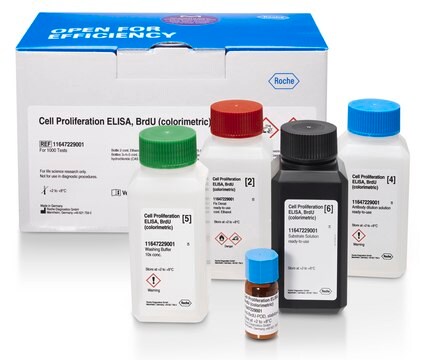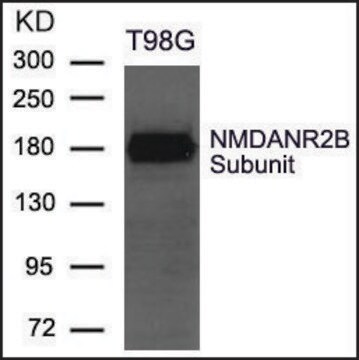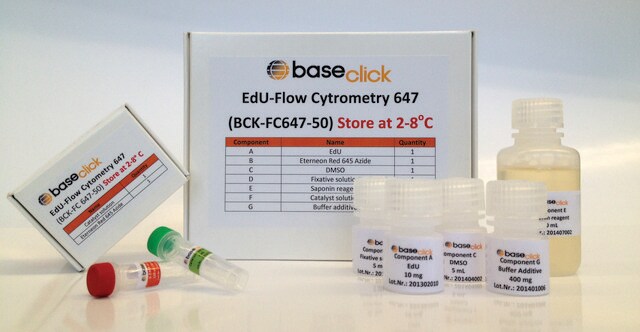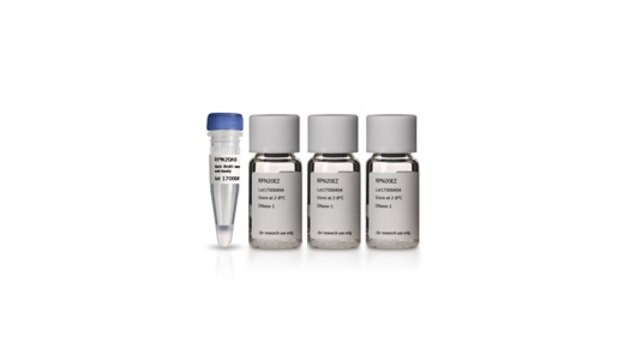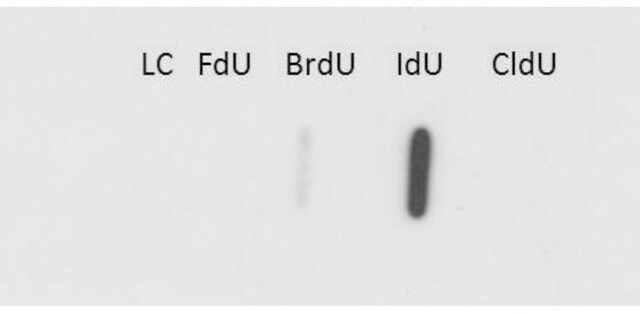推荐产品
生物源
mouse
品質等級
共軛
unconjugated
抗體表格
purified immunoglobulin
抗體產品種類
primary antibodies
無性繁殖
BMC9318, monoclonal
化驗
90% (HPLC and SDS-PAGE)
形狀
solution
包裝
pkg of 50 μg (500 μl)
製造商/商標名
Roche
同型
IgG1
儲存溫度
−20°C
一般說明
溴脱氧尿苷抗体是5-溴-2′-脱氧尿苷-5′-单磷酸的单克隆抗体。
特異性
该抗体能够与溴脱氧尿苷特异性结合,并与碘尿苷(10%)发生交叉反应。溴脱氧尿苷抗体与氟脱氧尿苷无交叉反应,并且与任何内源性细胞组分(如胸苷或尿苷)无交叉反应。
免疫原
表位明显位于DNA螺旋内。在抗体有效结合DNA-BrdU之前,必须将DNA变性为ssDNA。
應用
溴脱氧尿苷(Anti-BrdU)抗体适用于监测血液、组织和肿瘤中的增殖细胞,以及使用以下方法检测单细胞水平的BrdU掺入:
- 流式细胞术分析
- 免疫组织细胞化学分析
- 冷冻切片分析
- 石蜡切片分析
品質
通过以考马斯蓝染色的SDS-PAGE和HPLC检测,得到抗体纯度为90%。
規格
制备:用溴脱氧尿苷-牛血清白蛋白偶联物对BALB/c小鼠进行免疫。将从脾脏中分离的淋巴细胞与Ag8.653骨髓瘤细胞融合,产生BMC 9318克隆。抗体来源于BALB/c小鼠的腹水,并通过离子交换层析进行纯化。
测试次数:250次(流式细胞术)
测试次数:250次(流式细胞术)
外觀
稳定溶于磷酸盐缓冲盐水,pH 7.4,含有0.09%(w/v)叠氮化钠和0.2%(w/v)明胶。
準備報告
工作浓度:流式细胞术:2 μg/ml (0.2 μg/100 μl/106个细胞);免疫组织细胞化学分析:6 μg/ml
偶联物的工作浓度取决于应用和底物。应使用含0.1% BSA的PBS(pH 7.4)进行稀释,以维持抗体的稳定性。
偶联物的工作浓度取决于应用和底物。应使用含0.1% BSA的PBS(pH 7.4)进行稀释,以维持抗体的稳定性。
分析報告
溴脱氧尿苷抗体与碘-脱氧尿苷具有10%的交叉反应,但与氟-脱氧尿苷无交叉反应。
与任何内源性胸苷或尿苷均无交叉反应。
尚未测试其与5-Br-UTP的交叉反应,但是有研究人员认为存在交叉反应的可能性很大,因为它们的唯一区别是溴取代的远端核糖上没有羟基。
与任何内源性胸苷或尿苷均无交叉反应。
尚未测试其与5-Br-UTP的交叉反应,但是有研究人员认为存在交叉反应的可能性很大,因为它们的唯一区别是溴取代的远端核糖上没有羟基。
其他說明
仅用于生命科学研究。不可用于诊断。
未找到合适的产品?
试试我们的产品选型工具.
儲存類別代碼
12 - Non Combustible Liquids
水污染物質分類(WGK)
nwg
閃點(°F)
No data available
閃點(°C)
No data available
其他客户在看
Derek C Adams et al.
American journal of physiology. Renal physiology, 297(3), F809-F815 (2009-06-19)
Long-term pulse chase experiments previously identified a sizable population of BrdU-retaining cells within the renal papilla. The origin of these cells has been unclear, and in this work we test the hypothesis that they become quiescent early during the course
Wouter Laurentius Smit et al.
Proceedings of the National Academy of Sciences of the United States of America, 117(41), 25560-25570 (2020-09-30)
Deregulated global mRNA translation is an emerging feature of cancer cells. Oncogenic transformation in colorectal cancer (CRC) is driven by mutations in APC, KRAS, SMAD4, and TP53, known as the adenoma-carcinoma sequence (ACS). Here we introduce each of these driver
Erika A Correll et al.
IBRO neuroscience reports, 10, 31-41 (2021-04-17)
It has been demonstrated that adult born granule cells are generated after traumatic brain injury (TBI). There is evidence that these newly generated neurons are aberrant and are poised to contribute to poor cognitive function after TBI. Yet, there is
Xuexiao Li et al.
Cell death discovery, 8(1), 323-323 (2022-07-17)
Myelodysplastic syndromes (MDS) are characterized by daunting genetic heterogeneity and a high risk of leukemic transformation, which presents great challenges for clinical treatment. To identify new chemicals for MDS, we screened a panel of FDA-approved drugs and verified the neutrophil
Victoria Sofía Berenice Wies Mancini et al.
Glia, 67(2), 291-308 (2018-11-21)
Multiple sclerosis (MS) is one of the most common causes of progressive disability affecting young people with very few therapeutic options available for its progressive forms. Its pathophysiology involves demyelination and neurodegeneration apparently driven by microglial activation, which is physiologically
我们的科学家团队拥有各种研究领域经验,包括生命科学、材料科学、化学合成、色谱、分析及许多其他领域.
联系技术服务部门